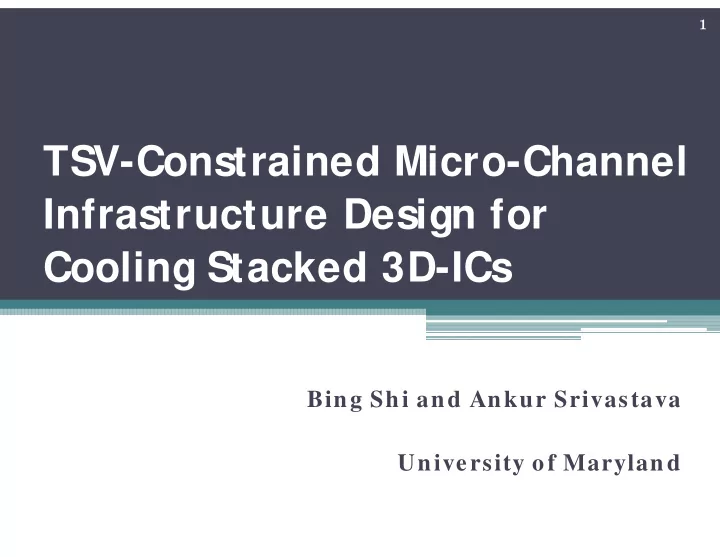

1 TSV-Constrained Micro-Channel Infrastructure Design for Cooling Stacked 3D-ICs Bing Shi and Ankur Srivastava University of Maryland
2 Motivation of active cooling Three dimensional circuits (3D-IC) Several vertically stacked layers High power density Thermal issue in 3D-IC: Micro-channel based interlayer liquid cooling
3 R elated work in micro-channel cooling for 3D-ICs Thermal and hydraulic modeling of micro-channel [Koo et al, JHT’05], [Kim et al, JHT’10], [Sridhar et al, ICCAD’10], [Mizunuma et al, ICCAD’09] Micro-channel optimization shape optimization for straight rectangular channel [Tuckerman et al, EDL’81], [Knight et al, CHMT’92] complex micro-channel structures [Jiang et al, IMECE’02], [Marques], [Senn et al, JPS’04] Hotspot optimized micro-channel design [Shi et al, DAC’11] DTM using micro-channel dynamic thermal management with flow rate control [Coskun et al, DATE’10]
4 Micro-channel design considerations • Conventional micro-channel structure: • straight channel • spread channels all over • Presence of TSVs • Variation in power/thermal profiles
5 S traight channel vs bended channel • Our previous work: hotspot optimized micro-channel micro channels • Straight channel vs bended channel Straight channel Bended channel
6 Key idea and design obj ective • Methodology of designing TSV-constrained micro-channel infrastructure • Micro-channels with bends • Better coverage of hotspot • Save cooling power
7 Thermal and hydraulic modeling Thermal modeling: conduction, convection, fluid flow
8 Thermal and hydraulic modeling Pumping power: � � ���� � � � � ∆� � ��� Straight channel (fully developed laminar) 2��� ∆� � � � � � � � � � � � � � � ���� � � � � � � � � � ∆� � 2��� ��� Bended channel: Fully developed laminar region • Corner region • Flow developing region •
9 Micro-channel structure design-problem formulation • Given: ▫ 3D-IC structure ▫ TSV locations ▫ Power profile ▫ Inlet and outlet orifices of micro-channels • Decide the structure of micro- channels
10 Micro-channel structure design –initial design Using min-cost flow based approach Node capacity: 1 Node cost: ∝ 1/� cooling demand)
11 Iterative micro-channel improvement Workload balancing Bend elim ination Unbalanced cooling demand Different number of bends
12 Performance of bended micro-channel vs straight micro-channel structure 46% cooling power saving on average
13 R esulting micro-channel structure Initial design After workload balancing After bend elimination
14 Thank you ! Questions?
Recommend
More recommend